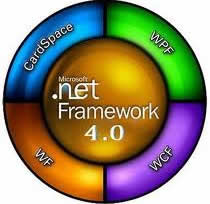Difference between .NET 3.5 and .NET 4.0
Key Difference: .NET is a software framework/infrastructure developed by Microsoft used to develop, run and deploy next generation of applications and XML Web services. .NET 3.5 and .NET 4.0 are two different versions of .NET. Its 4.0 version is more advanced and hence contains enhanced features than compared to 3.5.
 To bring the differences out, the concept of .NET Framework must be clear. As defined by the Microsoft, the .NET Framework is a consistent programming model for building applications that have visually stunning user experiences, seamless and secure communication, and the ability to model a range of business processes. .NET 3.5 and 4.0 are based on this particular definition but the difference emerges as 3.5 released before and 4.0 released later, providing the opportunity to developers to add extra functionalities and improve the framework
To bring the differences out, the concept of .NET Framework must be clear. As defined by the Microsoft, the .NET Framework is a consistent programming model for building applications that have visually stunning user experiences, seamless and secure communication, and the ability to model a range of business processes. .NET 3.5 and 4.0 are based on this particular definition but the difference emerges as 3.5 released before and 4.0 released later, providing the opportunity to developers to add extra functionalities and improve the framework

.NET Framework 3.5 was released on 19th November 2007 and .Net 4.0 was released on 12th April 2010. 4.0 contains all the basic features of 3.5 but improvements have been made in Common Language Runtime and Base Class Library. 4.0 also show improvements in data access methods and data modeling techniques. Enhancements have been also added to ASP.NET in the later version with features like new query filters, entity templates, more control over HTML etc. 4.0 also showcases improvements in Window Presentation Foundation and many more. In ASP.NET 4, requst validation is enabled for all requests by default and due to this change, those request validation errors occur which do not have occurred in 3.5. Some of the key differences have been highlighted in the table.
|
|
.NET 3.5 |
.NET 4.0 |
|
Definition |
A version of .NET framework that preceded .NET 3.0 |
A version of .NET framework that preceded .NET 3.5 |
|
Direct Access to Client Data |
No |
Yes, using client data view and client data context objects |
|
View State can be applied to the Control level |
No |
Yes, by using viewstate mechanism. |
|
Permanent URL redirection |
No |
Yes, by using RedirectPermanent() |
|
Size of installer |
2.7 MB |
869 KB |
|
Enhanced features compared to previous versions |
ASP.NET AJAX, Language Integrated Query (LINQ), enhanced Window Communication Foundation. |
Improvements in CLR , BCL, data modeling, parallel programming, asp.net enhancements etc. |
|
Output Caching |
Yes, with limitation |
Yes, easy to configure one or more custom output-cache providers. |
|
Size of Web config file |
Large due the Ajax, routing and integration with IIIS 7. |
Can be empty or small as major configuration elements have been moved to the machine.config file. |
|
Setting of Meta Tags |
Two meta tags can be used-
|
The keywords and meta tags can be included as part of page directive itself. |
|
A control to filter the data returns by EntitiyDataSource and LinqDataSource controls |
Not present |
Yes. QueryExtender Control |
|
Hashing Algorithm |
HMACSHA1 |
HMACSHA256 |
Image Courtesy: hanselman.com, gkiran511.blogspot.com









Add new comment